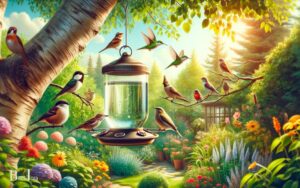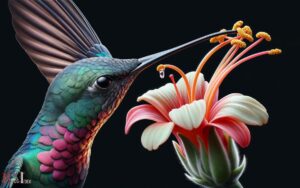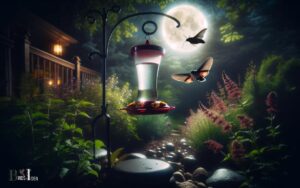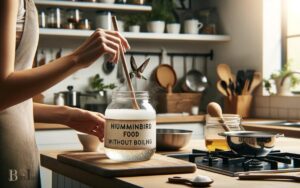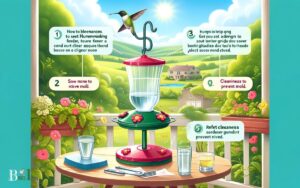How to Mix Hummingbird Nectar Concentrate? 3 Easy Steps!
Creating the perfect hummingbird nectar from concentrate involves mixing one part of the concentrate with three to four parts of water.
This ratio ensures a sugar concentration similar to that of natural flower nectar, which is ideal for hummingbirds.
Quick Steps:
For instance, if you have a quarter cup of nectar concentrate: – Mix it with three-quarters to a full cup of water.
Attract hummingbirds with ease by mixing nectar concentrate to mirror the sweetness of nature’s floral bounty.
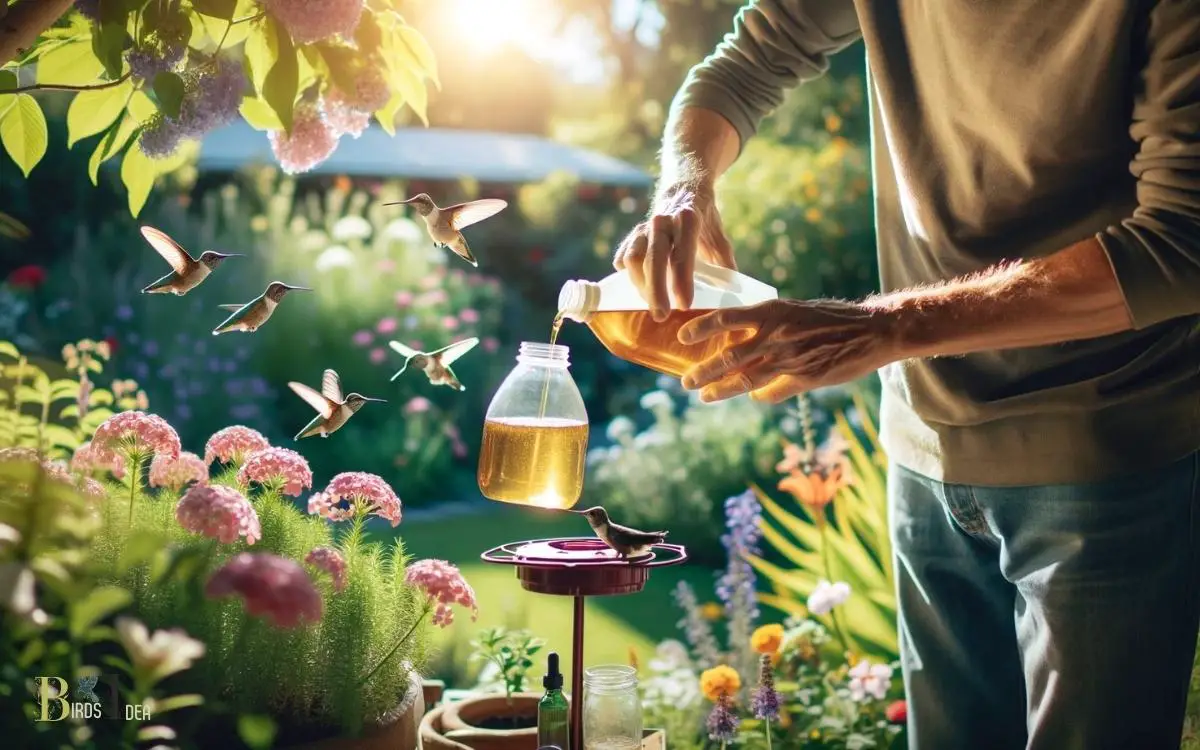
Key Takeaway
Understanding Hummingbird Nectar Concentrate
Understanding Hummingbird Nectar Concentrate requires knowledge of its composition and proper mixing ratios. The nectar concentrate is typically made of refined white sugar and water.
It’s essential to use only pure white granulated sugar, as alternatives like honey, brown sugar, or artificial sweeteners can be harmful to the hummingbirds.
The proper mixing ratio is four parts water to one part sugar. This ratio closely mimics the sucrose levels found in natural flower nectar, providing the essential energy source for hummingbirds.
It’s crucial to mix the concentrate thoroughly to ensure the sugar completely dissolves in the water.
Understanding the importance of maintaining the cleanliness of feeders and regularly changing the nectar is vital for the well-being of the hummingbirds.
Gathering the Necessary Supplies
Before mixing hummingbird nectar concentrate, it’s crucial to gather the necessary supplies. This includes having essential nectar mixers and ensuring proper sugar measurement.
By having these supplies on hand, you’ll be ready to proceed with mixing the nectar concentrate for your hummingbird feeders.
Essential Nectar Mixers
How do you ensure you have all the necessary supplies to mix hummingbird nectar concentrate?
Gathering the essential nectar mixers is crucial to providing the best care for our feathered friends.
To start, you will need a clean, large mixing container that is easy to handle and has a secure lid.
Additionally, it is important to have a reliable measuring cup to accurately portion the nectar concentrate and water.
A long-handled mixing spoon or whisk will help ensure thorough blending without creating a mess.
Lastly, make sure to have a clean funnel on hand to safely transfer the nectar mixture into your hummingbird feeders.
By gathering these essential nectar mixers, you can guarantee a smooth and efficient process when preparing hummingbird nectar concentrate for the delightful visitors in your garden.
Proper Sugar Measurement
To ensure accurate sugar measurement and gather the necessary supplies for mixing hummingbird nectar concentrate, it is essential to have a reliable measuring cup and a clean, large mixing container with a secure lid.
A high-quality measuring cup is crucial for precise sugar amounts, ensuring a balanced nectar concentration that will attract and nourish hummingbirds.
Choose a measuring cup with clear markings and a flat base for stability. Additionally, a large mixing container with a secure lid is necessary to thoroughly dissolve the sugar in water and store any excess nectar.
Look for a container that is easy to clean and has a tight-fitting lid to prevent contamination. By using these essential supplies, you can prepare an optimal hummingbird nectar mixture to delight and support these beautiful creatures.
Step 1: Mixing the Nectar Concentrate
When mixing hummingbird nectar concentrate, it is important to follow the manufacturer’s instructions precisely to ensure the proper ratio of water to concentrate.
Start by boiling the water and allowing it to cool before adding the concentrate. Typically, the ratio is one part concentrate to four parts water, but this may vary by brand, so carefully read the label.
Stir the mixture until the concentrate is completely dissolved. It is crucial to avoid adding extra concentrate, as this can harm the delicate digestive systems of the hummingbirds.
Once the nectar concentrate is thoroughly mixed with the water, it is ready to be used to fill hummingbird feeders.
Properly mixed nectar will help attract and nourish these beautiful birds. Next, we’ll cover the proper storage of the nectar solution.
Step 2: Proper Storage of Nectar Solution
When it comes to ensuring the longevity and quality of your hummingbird nectar solution, proper storage is essential.
Ideal storage conditions, such as keeping the solution in a cool, dark place, can help prevent mold and fermentation, preserving the nectar’s freshness.
Understanding the factors that affect the nectar’s shelf life can help maintain its quality for the enjoyment of hummingbirds.
Ideal Storage Conditions
Properly storing hummingbird nectar concentrate is essential to maintain its quality and freshness.
The ideal storage conditions for nectar solution involve keeping it in a cool, dry place away from direct sunlight.
It is best to store the concentrate in a tightly sealed container to prevent contamination and preserve its flavor.
Ensure that the storage container is clean and free from any residue to avoid spoilage or mold formation.
Additionally, it is recommended to label the container with the date of preparation to track its freshness.
By adhering to these ideal storage conditions, you can ensure that the hummingbird nectar concentrate remains in optimal condition, ready to be mixed and served to our delightful feathered friends.
Prevent Mold and Fermentation
To prevent mold and fermentation of the hummingbird nectar concentrate, it is crucial to maintain the ideal storage conditions discussed previously, such as keeping it in a cool, dry place away from direct sunlight and storing it in a tightly sealed container.
Proper storage helps in preserving the nectar solution, ensuring that it remains fresh and safe for the hummingbirds.
Consider the following to prevent mold and fermentation:
- Choose the Right Container: Opt for a food-grade, non-reactive container, such as glass or BPA-free plastic, to store the nectar concentrate.
- Regular Inspection: Periodically check the nectar solution for any signs of mold or fermentation, and promptly discard and clean the container if any issues are detected.
- Rotation: Use a “first in, first out” approach to ensure that the nectar concentrate is always fresh and at its best quality for the hummingbirds.
Length of Nectar’s Freshness
The freshness of the nectar solution is influenced by its proper storage, which directly impacts its longevity and suitability for hummingbirds.
To maintain the nectar’s freshness, store it in a clean, airtight container to prevent contamination and spoilage.
Keep the nectar solution in a cool, dark place, away from direct sunlight and heat, as exposure to these elements can accelerate the breakdown of the sugars in the solution.
Additionally, regularly check the nectar for any signs of cloudiness, discoloration, or unusual odor, as these may indicate spoilage.
When stored correctly, the nectar solution can maintain its freshness for up to 1-2 weeks, ensuring that hummingbirds are provided with a safe and nutritious food source.
Proper storage is essential in preserving the quality of the nectar and ultimately serving the needs of these delightful birds.
Step 3: Cleaning and Maintaining Feeders
Maintaining and cleaning feeders is essential for ensuring the health and well-being of hummingbirds.
It is crucial to keep the feeders clean to prevent the growth of mold and the transmission of diseases.
Here are some key steps for cleaning and maintaining feeders:
Regular Cleaning Schedule:
- Establish a regular cleaning schedule, such as every three to four days, to prevent the accumulation of dirt and mold.
- Use a mild soap and hot water to thoroughly clean the feeder, ensuring that no residue is left behind.
- Rinse the feeder thoroughly with clean water and allow it to dry completely before refilling it with fresh nectar.
- Inspect the feeder for any signs of wear and tear, and replace any worn parts to maintain its functionality.
Attracting Hummingbirds to Your Yard
Attracting hummingbirds to your yard requires strategic placement of clean, well-maintained feeders and the cultivation of hummingbird-friendly plants.
To entice these delicate creatures, position your feeders in areas that offer some protection from wind and direct sunlight.
Additionally, consider placing them near nectar-producing flowers, as the combination of feeders and flowers will create a visually appealing and inviting environment for hummingbirds.
When selecting plants, opt for trumpet-shaped flowers in vibrant shades of red, orange, or pink, as these colors are particularly attractive to hummingbirds.
Some popular choices include bee balm, salvia, and penstemon. Creating a welcoming habitat for hummingbirds not only brings joy to your own surroundings but also contributes to the welfare of these remarkable birds.
Are the Steps to Mix Hummingbird Nectar and Pennington Hummingbird Food the Same?
Yes, the steps to mix Pennington hummingbird food and hummingbird nectar are the same. Both require mixing the provided formula with water in the recommended proportions. Whether it’s homemade nectar or Pennington hummingbird food, the process ensures a balanced and nutritious solution for the tiny, energetic birds to enjoy in your backyard.
Tips for Successful Nectar Feeding
To ensure successful nectar feeding, it is essential to regularly monitor the condition of the feeders and replace the nectar as needed. This will ensure that the hummingbirds are receiving fresh and uncontaminated nectar.
Here are some tips for successful nectar feeding:
Cleanliness
- Regularly clean the feeders with a solution of hot water and vinegar to prevent mold and bacteria growth.
- Use a small brush to scrub the feeding ports and remove any residue.
- Rinse the feeders thoroughly with clean water before refilling them with fresh nectar.
- Ensure that the feeders are completely dry before refilling them to prevent contamination.
Conclusion
By following these simple steps, you can easily mix your own hummingbird nectar concentrate and attract these beautiful birds to your yard.
It’s ironic that such a small act of mixing nectar can have such a big impact on the environment and bring so much joy to those who witness the beauty of hummingbirds.
So, go ahead and mix up some nectar, set up your feeders, and enjoy the delightful sight of hummingbirds in your garden.


